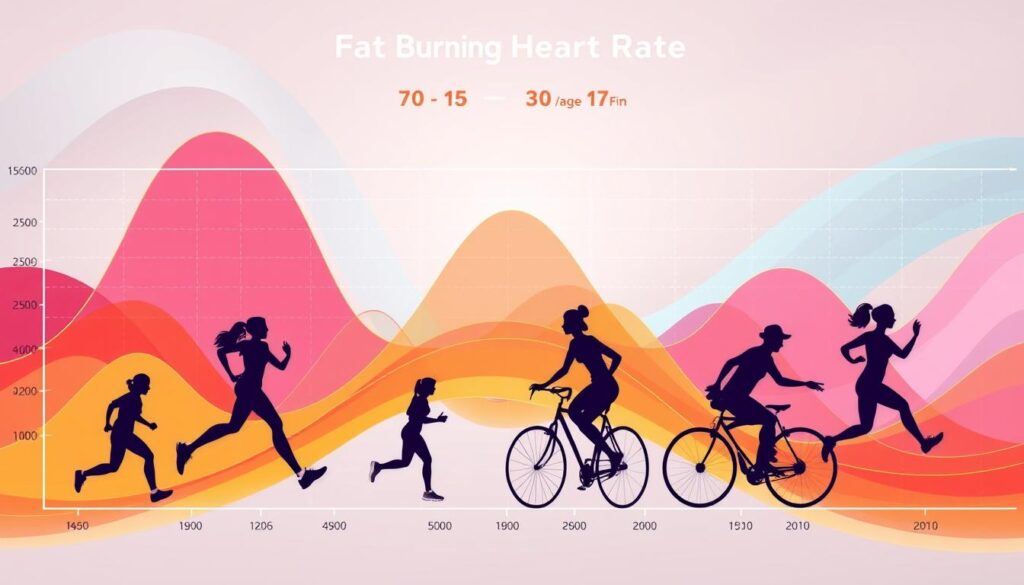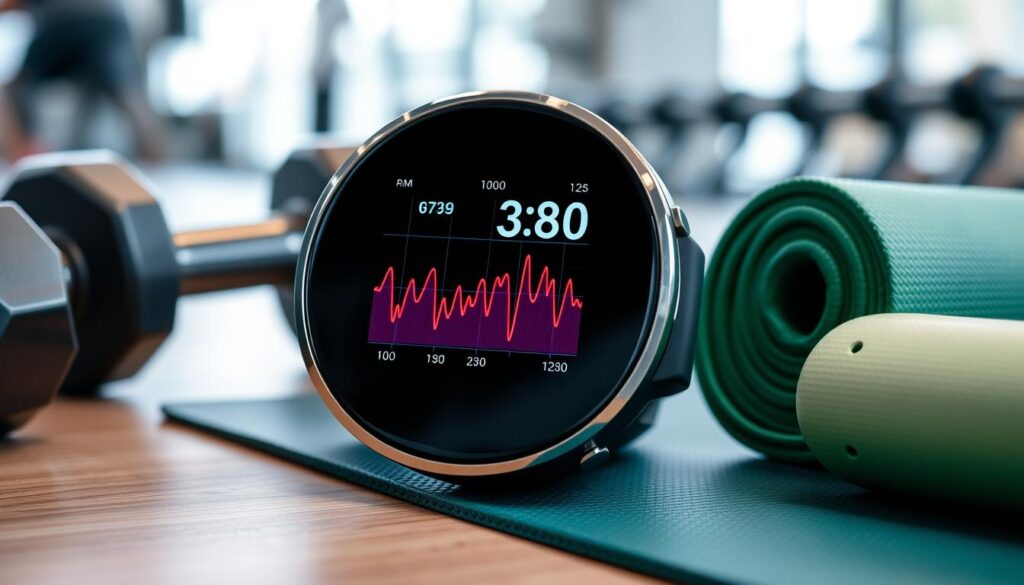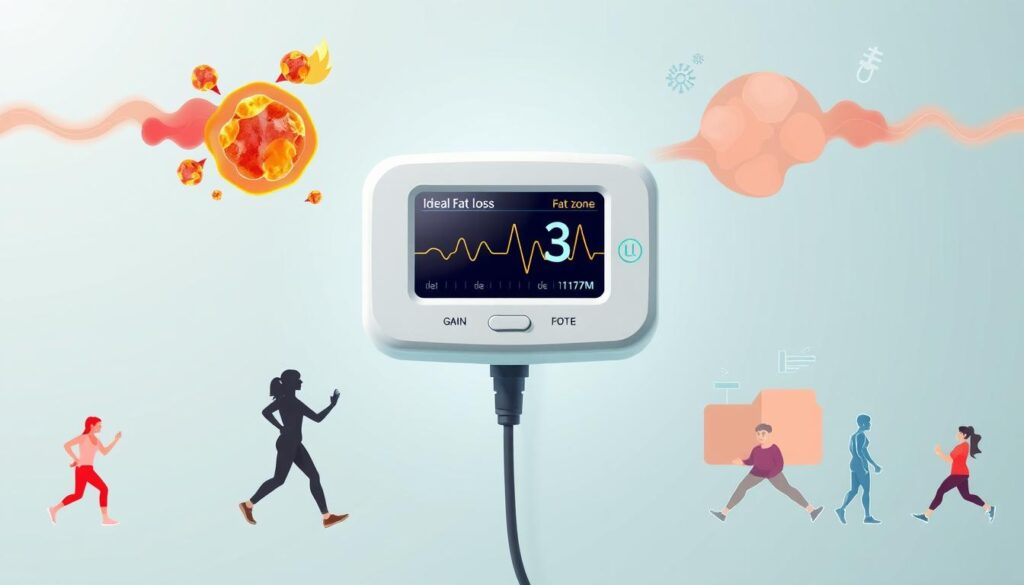To lose weight, you need a smart plan for how hard you exercise. Your heart rate is key to making your workouts work. It should be between 64% to 76% of your top heart rate. This can change based on your age, diet, and how fit you are.
If you’re a 40-year-old swimmer, aim for a heart rate of 115 to 137 beats per minute. This helps burn fat best. Keeping your heart rate in this range means your body uses fat for energy. This leads to more fat loss.
To find your fat-burning zone, use this formula: Maximum heart rate x 0.64 = lower end, and Maximum heart rate x 0.76 = higher end. The American Heart Association says you should exercise for at least 150 minutes a week. Staying in the fat-burning zone makes your workouts more effective.
Key Takeaways
- The fat-burning heart rate typically falls between 64% to 76% of your maximum heart rate.
- Your age, diet, and fitness level can affect your optimal fat-burning heart rate range.
- Maintaining your heart rate within the target fat-burning zone during exercise can lead to increased fat loss.
- The American Heart Association recommends at least 150 minutes of exercise per week for overall health benefits.
- Monitoring your heart rate can help you optimize your workout routine for maximum fat loss.
Understanding Fat Loss Heart Rate Fundamentals
Starting your fitness journey often begins with knowing your heart rate’s role in burning fat. Your resting heart rate is between 60 to 100 beats per minute. It helps set your target heart rate zones for exercise. Keeping your heart rate in the right zone helps burn fat and aids in weight loss.
Role of Heart Rate in Fat Burning
Your heart rate shows how hard you’re working out. Working out at a moderate pace makes your body use fat for energy. The best zone for burning fat is 70-80% of your max heart rate.
This target heart rate zone lets you keep a steady pace. It also helps you use your fat stores.
Metabolic Principles During Exercise
The energy your body uses changes with exercise intensity. At lower levels, it uses fat. At higher levels, it uses carbs. The “talk test” helps you know if you’re in the right zone.
If you can talk easily, you’re in the moderate-intensity zone. This is great for burning fat.
Energy Systems and Fat Utilization
Your resting metabolic rate is the energy for basic body functions. Any extra activity, like walking or HIIT, burns more calories. It also uses fat stores.
Knowing how your energy systems and fat work together helps create a good workout plan. This plan should match your weight loss goals.
“Monitoring your heart rate during exercise is a powerful tool for maximizing fat loss. By keeping your heart rate within the optimal fat-burning zone, you can effectively train your body to use stored fat as fuel, leading to sustainable weight management.”
Calculating Your Maximum Heart Rate Zone
Finding your maximum heart rate (MHR) is key to burning fat. Use the Fox formula: MHR = 220 – your age. For example, if you’re 35, your MHR is 185 beats per minute (bpm).
Your fat-burning zone is 70% of your MHR. For a 35-year-old, that’s about 130 bpm. The American Heart Association says work at 70-85% of your MHR for best fat burning. The lower end, 70-75%, is best for losing fat.
Your age affects your fat-burning heart rate. As you age, your MHR and fat-burning zone go down. Also, some medicines can change your heart rate. Always talk to your doctor if you’re worried.
| Age | Maximum Heart Rate (bpm) | Fat-Burning Zone (bpm) |
|---|---|---|
| 20 | 200 | 140-170 |
| 30 | 190 | 133-160 |
| 40 | 180 | 126-153 |
| 50 | 170 | 119-145 |
| 60 | 160 | 112-136 |
Knowing your MHR and fat-burning zone helps you exercise better. It’s all about being consistent and taking care of your health. This way, you can manage your weight well.
“Achieving your target heart rate is crucial for maximizing fat-burning during exercise. The key is finding the right balance and maintaining the optimal intensity level.”
The Science Behind Fat Loss Heart Rate Training
Knowing your heart rate zones is key for losing fat through exercise. The fat-burning zone is about 60% of your max heart rate. This is when your body uses fat for energy during aerobic exercise.
But, research shows the “fat-burning zone” isn’t the only way to lose fat. High-intensity interval training (HIIT) can lead to more fat loss. This is even if you burn less fat during the workout.
Understanding Different Heart Rate Zones
Your heart rate zones include:
- Resting heart rate: The rate at which your heart beats when you’re at rest.
- Moderate zone: 50-70% of your maximum heart rate.
- Target zone: 70-85% of your maximum heart rate.
- Maximum heart rate: The highest heart rate you can achieve during exercise.
Optimal Fat Burning Percentages
The best fat-burning zone is 55-75% of your max heart rate. At this level, your body burns more fat than carbs for energy.
Energy Source Utilization During Exercise
At low to moderate exercise, carbs are the main energy source. As intensity goes up, fat becomes more important. But, high-intensity exercise mainly uses carbs and the anaerobic system. This can still help with fat loss through calorie burn and afterburn effect.
To lose fat well, mix different exercise levels. Add a balanced diet and lifestyle to get lasting results.
Age-Specific Fat Burning Heart Rate Charts
Age is key when trying to burn fat for weight loss. Your target heart rate changes with age and fitness level. This is important for burning fat.
A 20-year-old’s fat-burning zone is 140-160 beats per minute (bpm). But for a 70-year-old, it’s 105-120 bpm. This change is because your maximum heart rate goes down with age.
The target heart rate zone for losing fat also changes with age. For a 20-year-old, it’s 100-170 bpm. For a 70-year-old, it’s 75-128 bpm.
It’s important to watch your heart rate while working out. Use a heart rate monitor or fitness tracker. This helps you stay in the right zone for burning fat.

Keep in mind, these heart rate ranges are averages. Your results can vary based on your fitness, gender, and more. Talking to a healthcare professional can help find your best fat-burning heart rate.
Best Exercises for Reaching Your Fat-Burning Zone
To burn fat well, you need to hit your heart rate zone. Knowing the intensity levels helps you make a workout plan. This plan boosts fat loss and heart health.
Low-Intensity Cardio Options
Low-intensity exercises like brisk walking and gardening are great. They help you burn fat and get stronger. These activities keep your heart rate between 50-70% of its max.
Moderate-Intensity Activities
Moderate workouts like running and swimming are good too. They use both fat and carbs for energy. This makes them good for cardiovascular exercise and weight management.
HIIT and Fat Burning
High-Intensity Interval Training (HIIT) is very effective. It mixes intense exercise with rest. This raises your heart rate to 80-90% of its max. It burns fat and keeps burning calories even after you stop.
Mixing different exercises helps you reach your fat-burning zone. This way, you can reach your fitness goals.
Heart Rate Monitoring Tools and Techniques
Tracking your heart rate is key for burning fat. You can use different tools to do this. One way is to count your pulse manually for 60 seconds.
Wristband fitness trackers can track your heart rate all the time. They also count steps and estimate calories burned. Chest strap monitors are great for swimming because they’re waterproof.
If you don’t have a heart rate monitor, try the talk test. It helps you know if you’re working hard enough. You can tell by how hard it is to talk while exercising.

Choosing the right method is important. It helps you work out better and burn fat. Always keep your form right and pace yourself well.
Common Mistakes in Fat-Burning Heart Rate Training
Reaching your fat loss goals means avoiding common heart rate training mistakes. Many think low-intensity workouts are best for fat burning. But, the truth is more complex.
Intensity Level Errors
Low-intensity exercise is good, but research shows moderate to high-intensity workouts are better for fat loss. Working out at 60-80% of your max heart rate uses more fat as fuel.
Duration Misconceptions
Don’t forget the importance of workout length. To lose fat, keep your heart rate in the right zone for at least 30 minutes. Short workouts don’t burn enough fat.
Recovery Period Oversights
Don’t ignore the need for rest between workouts. Skipping recovery time slows down fat loss. Let your body rest to get ready for the next workout.
By fixing these mistakes and focusing on the right intensity, duration, and rest, you’ll get better results. This way, you can reach your fat loss goals.
Optimizing Your Workout for Maximum Fat Loss
To lose fat, mix moderate to high-intensity workouts with a calorie deficit. Consistency is key. Aim for regular workouts all week. Use both steady-state cardio and interval training for best results.
Watch your heart rate to stay in the fat-burning zone, 60-70% of your max. But don’t forget high-intensity periods. They boost calorie burn and fitness.
Here’s how heart rate zones help with workout optimization:
- Zone 1 (50-60% of max HR): Burns fat, good for warm-ups and cool-downs.
- Zone 2 (60-70% of max HR): Burns fat and carbs, great for long activities.
- Zone 3 (70-80% of max HR): Burns carbs and fats, builds aerobic base.
- Zone 4 (80-90% of max HR): Burns carbs, efficient for high-intensity workouts.
- Zone 5 (90-100% of max HR): Burns carbs, best for HIIT.
Using different heart rate zones in your workouts optimizes fat loss and fitness. Find a balance between exercise consistency and challenging your body.
| Heart Rate Zone | Percentage of Max HR | Fuel Source | Workout Benefit |
|---|---|---|---|
| Zone 1 | 50-60% | Fat | Warm-up and cool-down |
| Zone 2 | 60-70% | Fat and Carbohydrates | Steady-state Cardio |
| Zone 3 | 70-80% | Carbohydrates and Fat | Aerobic Base Building |
| Zone 4 | 80-90% | Carbohydrates | High-Intensity Workouts |
| Zone 5 | 90-100% | Carbohydrates | HIIT Training |
Nutrition and Hydration for Enhanced Fat Burning
Good nutrition and drinking enough water are key for losing fat. Eat lots of whole foods like fruits, veggies, whole grains, lean meats, and low-fat dairy. Stay away from foods with added sugars and fats because they slow down fat loss.
Drinking water is also very important for burning fat. Try to drink at least 8 cups (64 ounces) of water a day. This helps a lot, especially if you’re active or live in a hot place. Don’t drink sugary drinks because they add empty calories and can stop your weight loss.
Pre-workout Nutrition Strategy
Before you work out, eat foods that are easy to digest. Mix carbs with a bit of protein. This gives you energy and helps burn fat. Good choices are a banana with nut butter, yogurt with berries, or whole-grain toast with an egg.
Post-workout Recovery Fuel
After working out, eat foods that help your muscles recover. Mix protein with carbs. This helps your muscles and keeps burning fat. Try a protein shake with fruit, or lean protein like chicken with sweet potatoes or quinoa.
| Nutrient | Benefits for Fat Burning |
|---|---|
| Water |
|
| Protein |
|
| Carbohydrates |
|
By eating right and drinking enough water, you can burn fat better. This helps you reach your weight loss goals.
Conclusion
Knowing your fat loss heart rate helps a lot with losing weight. You need to exercise right, eat well, and drink enough water. This way, you burn fat better and keep your heart healthy.
Don’t forget, losing weight too fast is not good. Aim for 1-2 pounds a week. Always talk to doctors for advice that fits you.
Staying consistent is important for keeping weight off. Learning about fat-burning heart rates helps you make better workouts. This way, you lose fat and get fitter.
Your heart rate is a big help in losing weight. Use heart rate monitors to guide you. With hard work and the right plan, you’ll get healthier and fitter.


A Life-Changing Experience with This Weight Loss Supplement (Nagano Tonic)
I’ve always struggled with finding a weight loss solution that actually works for me. Like many, I’ve tried numerous diets, exercise routines, and supplements over the years—some worked for a short time, but nothing ever gave me long-term results. That was until I decided to try the weight loss supplement I found : Link to the Supplement.
From the moment I started using it, I noticed a difference. Not only did I feel more energized, but my cravings also became more manageable. The best part? I started seeing results much quicker than I anticipated! Over the course of just a few weeks, I noticed a significant reduction in belly fat and overall weight loss that I hadn’t been able to achieve before.
What makes this supplement stand out from all the others I’ve tried is how it supports me in my daily routine without any jitters or energy crashes. I’m able to stay focused and motivated, which has made it easier to stay on track with my diet and exercise plan.
This product truly exceeded my expectations, and I feel more confident and healthier than ever before. If you’re struggling with your weight loss journey like I was, I highly recommend giving this supplement a try. It’s been a game-changer for me, and I’m sure it can work wonders for you too!
Contant Them on email .. tonicnagano50@gmail.com
I’ve tried so many weight loss products over the years, but nothing worked like this supplement! Since I started using it, I’ve noticed a big difference in my energy levels and appetite control. In just a few weeks, I’ve lost weight and feel so much better. It’s been easy to stick with, and the results speak for themselves. Highly recommend this to anyone looking to make a real change!
I was skeptical at first, but this supplement has truly made a difference in my weight loss journey. I’ve lost weight without feeling deprived or sluggish. My cravings are under control, and I feel more confident in my body. It’s easy to incorporate into my daily routine, and the results speak for themselves. I’m so glad I gave it a try!
Thanks David, i do use the link to make my purchase. you can get too here http://surl.li/iasppy
I’ve tried so many weight loss products, but this one has been by far the most effective. In just a few weeks, I’ve noticed a visible difference in my body and energy levels. It’s helped me stay on track without the constant hunger pangs and cravings. I’m really happy with my progress and can’t wait to see where I’ll be in another month!
This Nagano Tonic has been amazing! In just a few weeks, I’ve lost weight, feel more energized, and my cravings are under control. Highly recommend it!
Thats the link to purchase http://surl.li/iasppy